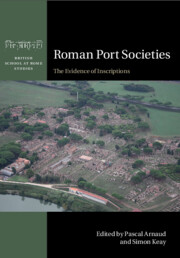Book contents
- Roman Port Societies
- British School at Rome Studies
- Roman Port Societies
- Copyright page
- Contents
- Figures
- Tables
- Contributors
- Abbreviations
- 1 The Context of Roman Mediterranean Port Societies
- 2 Inscriptions and Port Societies
- 3 Stationes and Associations of Merchants at Puteoli and Delos
- 4 Boatmen and their Corpora in the Great Ports of the Roman West (Second to Third Centuries AD)
- 5 Roman Port Societies and Their Collegia
- 6 Port Occupations and Social Hierarchies
- 7 Warehouse Societies
- 8 The Imperial Cult and the Sacred Bonds of Roman Overseas Commerce
- 9 Law and Life in Roman Harbours
- 10 Living Like a Cosmopolitan?
- 11 Ports, Trade and Supply Routes in Western Europe
- 12 The Port Society of Narona
- 13 Municipal Authority, Central Authority and Euergetists at Work at the Port
- 14 The Structure of Mercantile Communities in the Roman World
- 15 Polysemy, Epigraphic Habit and Social Legibility of Maritime Shippers
- 16 Reading Roman Port Societies
- Indexes
- References
6 - Port Occupations and Social Hierarchies
A Comparative Study through Inscriptions fromHispalis, Arelate, Lugdunum, Narbo Martius,Ostia-Portus and Aquileia
Published online by Cambridge University Press: 30 October 2020
- Roman Port Societies
- British School at Rome Studies
- Roman Port Societies
- Copyright page
- Contents
- Figures
- Tables
- Contributors
- Abbreviations
- 1 The Context of Roman Mediterranean Port Societies
- 2 Inscriptions and Port Societies
- 3 Stationes and Associations of Merchants at Puteoli and Delos
- 4 Boatmen and their Corpora in the Great Ports of the Roman West (Second to Third Centuries AD)
- 5 Roman Port Societies and Their Collegia
- 6 Port Occupations and Social Hierarchies
- 7 Warehouse Societies
- 8 The Imperial Cult and the Sacred Bonds of Roman Overseas Commerce
- 9 Law and Life in Roman Harbours
- 10 Living Like a Cosmopolitan?
- 11 Ports, Trade and Supply Routes in Western Europe
- 12 The Port Society of Narona
- 13 Municipal Authority, Central Authority and Euergetists at Work at the Port
- 14 The Structure of Mercantile Communities in the Roman World
- 15 Polysemy, Epigraphic Habit and Social Legibility of Maritime Shippers
- 16 Reading Roman Port Societies
- Indexes
- References
Summary
From small fishermen to tradesmen, port societies werecomposed of a broad range of occupations, whichbrought differing levels of income and prestige tothose who practised them. Literary sources onlymention a limited number of port activities, oftensituated at both ends of the social hierarchy, inparticular the traders at the top and the fishermenat the bottom. Epigraphic sources allow us to bemore specific about this hierarchy. First, far frombeing generalizing, they refer to particular portcontexts, even if all the information is notavailable. Moreover, the inscriptions were oftencreated by professionals themselves or by people whowere in contact with them and who probably knew thembetter than the élite who wrote about them. Theinscriptions also have the advantage of using aprecise vocabulary that allows us to know about theexistence of some activities that are unknown inliterary sources. This is an advantage, but it canalso be an inconvenience, because without anyreference in literature it is sometimes difficult toknow the exact meaning of the Latin words.Difficulties in determining the meaning of a wordcan also be encountered with well-documented words,like navicularius,something that makes us realize how important it isto take into account the contexts in which a word isemployed. The aim of this chapter is to try to findclues for hierarchical relationships betweendifferent attested occupations. Are there anyactivities that are more prestigious than others, orthat allow their members a better degree of socialmobility? Alternatively, do some activities condemnthose who practise them to remain at the bottom ofthe social scale? Is the hierarchy of occupationsidentical at each port?
- Type
- Chapter
- Information
- Roman Port SocietiesThe Evidence of Inscriptions, pp. 132 - 151Publisher: Cambridge University PressPrint publication year: 2020

